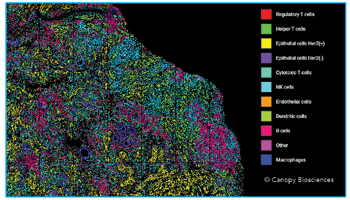Spatial Biology: What it is, why it matters, how to access it.
What is Digital Spatial Profiling?
What is Digital Spatial Profiling?
Digital spatial profiling is revolutionizing spatial biology, offering a powerful tool to understand the spatial organization of biomolecules within biological samples. This blog will cover the technology of digital spatial profiling, its applications in the life science industry, and how to pair it with multiplexed protein detection to generate the most impactful results.
Digital Spatial Profiling in Spatial Biology
Digital spatial profiling is the quantitative analysis of RNA within tissue samples to discover gene expression with spatial context. By combining imaging, molecular profiling, and advanced computational analysis, researchers gain valuable insights into the spatial relationships of cells, tissues, and biological structures.
The digital spatial profiling workflow utilizes specific probes to identify regions of interest in a tissue sample as well as high-plex RNA panels. Spatial information is provided by morphology markers to identify target cell types, which then determine the regions of interest (ROIs) for downstream molecular profiling via targeted gene expression analysis or next generation sequencing (NGS).
1. Stain: Stain the slides with morphology markers to highlight tissue architecture and RNA detection probes targeted to marker-specific regions.
2. Select: Select regions of interest based on protein marker detection.
3. Image and Profile: Image and perform Digital Spatial Profiling of RNA using the GeoMx® platform from Nanostring®.
4. Count and Quantify: Quantify gene expression levels using NanoString nCounter® targeted transcriptional analysis or NGS.
5. Analyze and Compare: Analyze the data with user-friendly software to compare specific targets, bringing you one step closer to publishing your results.
Applications of Digital Spatial Profiling in Life Science
Digital spatial profiling has diverse applications in life science research, including:
1. Disease Research: Unlocking spatial heterogeneity in diseased tissues, identifying biomarkers, and assessing therapeutic responses.
2. Drug Discovery and Development: Enabling the development of targeted therapies, understanding drug resistance mechanisms, and evaluating drug impact on specific cell populations.
3. Biomarker Discovery: Facilitating the identification and validation of spatially localized biomarkers for diagnostics and personalized medicine applications.
4. Tissue Engineering and Regenerative Medicine: Optimizing tissue engineering strategies, characterizing tissue architecture, and monitoring cell behavior for successful tissue regeneration.
Benefits and Limitations of Digital Spatial Profiling in Spatial Biology
Digital spatial profiling offers the benefits of comprehensive RNA profiling with spatial context and without sequencing bias as well as integration with other omics data. However, measuring mRNA is only a proxy for protein levels and may not be an accurate measure due to post-transcriptional effects. Pairing a high-throughput transcription discovery technique with a highly multiplexed, quantitative protein detection platform is the ideal way to confirm discoveries and validate hypotheses. Our CellScape™ automated staining and imaging platform, featuring ChipCytometry™ technology, can both detect and quantify a nearly unlimited number of protein biomarkers from a tissue sample with single-cell resolution.
Access to Digital Spatial Profiling
Digital spatial profiling is revolutionizing spatial biology in the life science industry. Pairing spatial transcriptomic analysis with the CellScape for highly multiplexed protein detection provides valuable insights into spatial organization, disease mechanisms, and therapeutic interventions. If you do not have Digital Spatial Profiling or ChipCytometry capabilities in your own lab, reach out to our scientists at Canopy Spatial Solutions™. We are the only research partner with expertise in both technology platforms and can carry your next spatial biology project from concept to completion.



